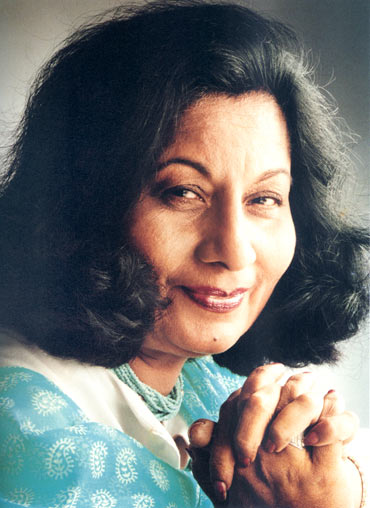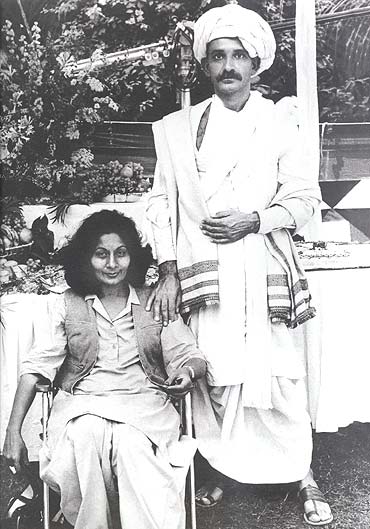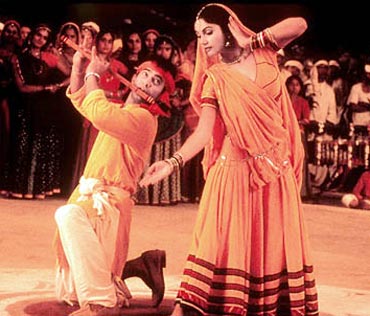
Whether it's Guide, Gandhi or Lagaan, think of any trend-setting Indian film, and chances are the costumes were designed by Bhanu Rajopadhye Athaiya. According to Richard Attenbourough, the director of the Oscar-winning film, Gandhi, it took him 17 years to set up the film, and only 15 minutes to make up his mind that Bhanu was the right person to design its costumes.
Bhanu comes from a privileged family -- her father was a man of leisure, indulging his artistic passions and interests while encouraging his large family of a wife and seven children to do the same. It was this encouragement that led Bhanu out of her sprawling house in Kolhapur to the city of Bombay [now Mumbai], in order to pursue her passion -- studying art at the JJ School of Arts. "Travelling to Bombay was very exciting for me. It had been a dream for a long time, and I felt like it was finally happening. I made the journey with my art teacher from Kolhapur, who had convinced my mother to send me," recounts Bhanu.
The next milestone in Bhanu's life was her job at a magazine called Eve's Weekly, where her fashion illustrations would appear in each issue, making her a known name. So when the magazine opened a fashion boutique, Bhanu was designing a lot of its creations. Her customers included actresses Kamini Kaushal and Nargis, who would eventually introduce her to films and costume design. Soon filmmakers like B R Chopra and Yash Chopra started frequenting the store, and Bhanu found herself at a fork in the road. She could choose to continue fashion design or move to costume design. The lure of a wider scope and more exciting work made the choice for her, and she became a full-time costume designer.
In a tete-a-tete with Insiyah Vahanvaty, Bhanu talks about the films she has designed for, how Gandhi happened, and what it means to be a woman in a man's world.
Tell us about the crowning glory of your career -- the film Gandhi -- that fetched you the Oscar award.
By the time Gandhi came about, I was already well-established and successful in my country [India]. But when Richard Attenbourough visited India, he knew that nobody but an Indian would be able to design the costumes, because of our country's complexities. He held auditions for costume designers, and I was asked to go there as well. Within 15 minutes, the director told his crew that he had found his designer! As for the Oscar...it was not something that had crossed my mind. I mean, I was in Bombay, LA was so far away why dream of such unlikely things? And I had won awards here.
But when I returned after winning the award, people here would ask me, "Madam, why did you win the award? Everything in the film looks so normal," whereas a more knowledgeable designer from the West said to me, "We all think India comes ready -- all you have to do is point your camera and shoot. But my compliments to you, because the film covers a span of 50 years. That's not easy to do."
The clothes for Gandhi couldn't have been picked out of a store or off the rack. At the Oscar award ceremony, the other designers who had been nominated -- my competitors told me that they felt like they didn't even stand a chance, because my canvas was so large.

What was it like taking up such an unusual career option at a time when nobody knew what a costume designer was?
See, I didn't go looking for a job. I was a gold medalist from the JJ School of Arts, so I was a trained artist. It was while I was working at Eve's Weekly as a fashion illustrator that my sketches got noticed and highly appreciated. I was approached by the film industry to design for films. Film directors would come to the magazine's boutique workshop. It was because I was getting such a tremendous response that I decided to leave and join the film industry. I didn't have to knock on any doors for work, so I didn't face any hurdles.
Before I entered the scene, things worked very differently. What one saw in the film industry was that the director and set designer would put their heads together and call in a tailor. Or go shopping. My stepping in relieved them of this tension. I would listen to the director, make a sketch, meet the actor and finalise the outfit. In that era, the director was king -- the actors didn't present any problem at all.
Which are the films you think had the best costumes?
First, let me explain what costume design is. It's not the same as fashion design where the clothes have to be beautiful and glossy. Costume design is the art of creating a character and look. That depends on the film and its story.
If I absolutely have to choose, I would say, Meena Kumari's clothes in Guru Dutt's film, Sahib, Bibi aur Ghulam, Vaijanthimala's clothes in Amrapali, Mumtaz's outfits in Bhramachari, Wahida Rehman in Reshma aur Shera, and Shahrukh Khan in Swades.
These are all costumes designed by you. Is there anyone else whose work you admire?
Nobody can match me in this country. My work is the best in India.

What do you do when you're not working?
I have always been highly sought after -- I work on Indian films, foreign films, regional films, theatre so I'm always very busy. I wake up at 6 am, full of enthusiasm and raring to go. I work for 8-10 hours and then call it a day. I don't go for parties -- if I go out, it's to go for exhibitions or films. And when I travel, which is a lot, I visit museums. This is all part of my education. Because in India, if I have to work on period films, it's hard to get references here. I buy lots of books from abroad to bring back. They help me in my work. For example, this is what helped me create the British regiment uniforms in Lagaan.
Tell us about your book The Art of Costume Design.
The book contains the highlights of my career -- some of the costumes I have designed, which people will definitely remember. It also talks about my life, telling you all about my background, how I started in this line of work, etc. It's more of a pictorial coffee-table book, but has all the information my readers would want about me.
How do you balance work and personal life?
Well, I am single, so there aren't many demands on my time. Actually, it's simple-- work comes first. Everything else comes after that. If people are born for a certain thing, they must do that -- they must give their vocation everything they have. Else the world will be the loser if gifted people don't share their gifts.
Everyone has to listen to their heart -- if I didn't, I would be unhappy. Everyone who is close to me has to understand that and not throw tantrums. I don't tolerate that.

Being a woman, was it hard to break into a male dominated world?
My work was noticed from the beginning, and there was no competition for me. My ideas were accepted so where is the question of struggle? Everything came on a platter for me. People believed in me. As a woman, where I have broken ground is -- when I came to Mumbai at 17 years of age, I got a part-time job while studying and told my mom not to send me any money anymore. This is the example women should follow -- have independence and command over your life. That is a great thing. If a woman is self sufficient, she is unrestricted. She can then do so much!
What does it take to be a successful woman?
I would like to tell women to find what their vocation is at a young age and give their best shot to it. Work hard, be good at what you do and you will get noticed. I don't go chasing press people, or try to get publicity. My work speaks for itself. And remember, you will be competing with men, so you have to be the best -- otherwise they won't accept you. I didn't have that problem, so it was okay for me.
Any advice for young people?
Not so much for youngsters, but I do have something to say to their parents. They should notice their children's aptitude and nurture it. They should introduce their children to new things, expose them to various experiences children need to discover themselves. As a child, I was exposed to art, which is what made me discover my art. This happened because I have enlightened parents. For me, as a budding art lover, I was given all the materials I needed to develop my passion.
What are your future plans?
I am working on my second book right now. Since I have designed costumes for some 200 films, I can't cover it all in one book. So the second book will cover what the first one couldn't. And of course, I'm doing my regular work.